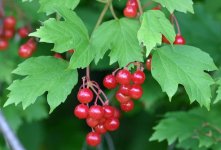Viburnum vulgaris - viburnum opulus l.
Family Hyperaphist - Caprifoliaceae
Botanical characteristics. Shrub or a small tree. The bark of young shoots is light gray, sometimes yellowish-brown, old - darker, fissured, scaly. Depending on the type of plant, the shape of the leaves can vary on the same plant: rounded, obovate, elliptical, lobate with a wedge-shaped or shallow-heart-shaped base. Inflorescences in the form of a loose umbelliform panicle. The flowers are white, with bracts falling after flowering. Marginal infertile, flat; Middle - bell-shaped bisexual. Fruits - stems, globose, juicy, red. Stone slightly flattened. Blossoms in June - July, fructifies in August - September.
There are several species, introduced into the culture. All species are similar in chemical composition, have similar healing properties, are used in medicine similarly.
Spread. It grows in the underbrush, on the fringes, in sufficiently moistened soils, in river valleys, along the banks of rivers and lakes, mainly in clarified places.
Used parts of the plant. Medicinal raw materials are fruits, leaves, flowers, bark, less often roots harvested in the usual way during the entire vegetation period of the plant.
Chemical composition. The bark contains tannins, saponins of the triterpene group, glycoside viburnin, phenolcarbonic and organic acids, mainly formic, acetic, valeric, capric, caprylic, oily, linoleic, cerotinic, palmitic; Phytosterol and phytosterolin, fobafenes, myricyl alcohol and other chemical compounds.
Fruits contain sugars, vitamins C, R, K, carotene, essential oil, pectins, tannins, organic acids (citric, malic, coffee, oxalic, chlorogenic, ursolic, isochlorogenic, neochlorogenic), army, sitosterol.
Flowers contain flavonoids, in seeds - fatty oil.
Application. The bark is included in the pharmacopoeias of many countries of the world. In folk medicine decoctions of bark, flowers and fresh fruits are used for insomnia, respiratory infections, as a sedative, astringent, diuretic, laxative, with scrofula in children, as choleretic, cardiostimulating, anti-inflammatory and hypotensive.
In medical practice, preparations of viburnum are used to strengthen the tone of the uterus, as an antiseptic, hemostatic, analgesic.
In the experiment the preparations of the Kalina show adaptogenic effect, have a sedative, anti-estrogenic effect, show a diuretic effect. They reduce the amount of cholesterol in the blood, regulate blood pressure, normalize lipid metabolism and kidney circulation, stimulate blood clotting, and have cardiotonic action. Cortical preparations have a pronounced hypotensive and sedative effect.
Infusions and decoctions of flowers are used for painful menstruation, threatening miscarriage, as an antiseptic and expectorant. The fruits of the viburnum strengthen the contraction of the heart, increase diuresis, are a vitamin, diaphoretic, laxative. They are taken with gastritis, decreased secretion and for the prevention of ulcers and stomach cancer, bronchitis, liver disease, pneumonia, cough, hoarseness, colds, jaundice.
Fresh juice of leaves and flowers is a fortifying aid after serious illnesses; It is used as anti-inflammatory, with angina and laryngitis (hoarse voice). They smear the affected areas of the skin with various skin diseases, hemorrhoidal cones, and also bleach the bleached face, darkened and sunburned in the sun and wind, freckles and pigment spots - chloasma.
The juice is taken 20-30 g 3 times a day.
Preparation
- To prepare the infusion, take 20 g of flowers or leaves, pour 200 ml of boiling water, insist on a water bath for 15 minutes, cool 30-45 minutes, filter. Take 1/3 cup 3 times a day
- For broth 15 g of bark or fruit pour 180 ml of boiling water, insist on a boiling water bath for 30 minutes, cool 10 minutes, filter, bring to the desired volume. Take decoction of bark for 2 tbsp. Spoon 3 times a day. The broth of fruits is taken 50 ml 3-4 times a day after meals.
- At home, you can prepare an extract of the bark of a Kalina. To do this, take the bark powder (1 part) and 10 parts of 50% alcohol, insist 10 days in a warm place, filter. Take should be 30-40 drops per reception 3-4 times a day.
- The juice of the viburnum is prepared in the autumn. Berries are washed, passed through a juicer. The juice is mixed with sugar (preferably in a mixer), at the rate of 1 kg (juice, not berries!) For 2 kg of granulated sugar. The resulting mixture for 5-10 days has a bitter taste, then the bitterness disappears and the juice becomes pleasant to taste. With him they drink tea, prepare fruit and jelly, it is added to the infusion of herbs. If the freshly made vine juice is put in the refrigerator, the bitterness disappears after 1-2 days.
Homeopathy. Homeopathic Viburnum 3x, 3, 6 is prepared from the fresh bark of the viburnum and is used mainly for the treatment of gynecological diseases: with painful menstrual, threatening miscarriages, postnatal pains, for the treatment of dysmenorrhea.





Comments
When commenting on, remember that the content and tone of your message can hurt the feelings of real people, show respect and tolerance to your interlocutors even if you do not share their opinion, your behavior in the conditions of freedom of expression and anonymity provided by the Internet, changes Not only virtual, but also the real world. All comments are hidden from the index, spam is controlled.